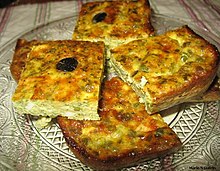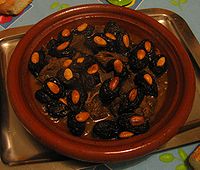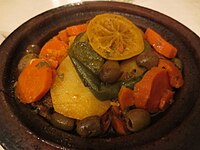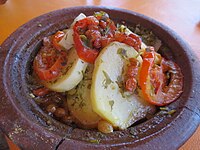What Tunisians refer to as a "tajine" is very different from the Moroccan dish.[5] Tunisian tajine is more like an Italian frittata. First, a simple ragout is prepared, of meat cut into very small pieces, cooked with onions and spices, such as a blend of dried rosebuds and ground cinnamon known as baharat or a robust combination of ground coriander and caraway seeds; this is called tabil.[6] Then something starchy is added to thicken the juices. Common thickeners include cannellini beans, chickpeas, breadcrumbs or cubed potatoes. When the meat is tender, it is combined with whatever ingredient has been chosen to be the dominant flavoring. Examples include but are not limited to fresh parsley, dried mint, saffron, sun-dried tomatoes, cooked vegetables, or even stewed calves' brains. Next, the stew is enriched with cheese and eggs. Finally, this egg and stew is baked in a deep pie dish, either on the stove or in the oven until top and bottom are crisply cooked and the eggs are just set. When the tajine is ready, it is turned out onto a plate and sliced into squares, accompanied by wedges of lemon. Tunisian tajines can be made with seafood or as a completely vegetarian dish.
In rural parts of Tunisia, home cooks place a shallow earthenware dish over glowing olive wood, fill it, cover it with a flat earthen pan, and then pile hot coals on top. The resulting tajine is crusty on top and bottom, moist within, and is infused with a subtle smoky fragrance.
Read More
















